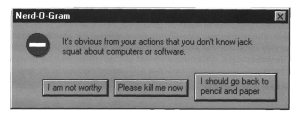The Federal government has warped the fabric of healthcare. By giving away money. They’ve done this both to doctors’ offices and hospitals, for “meaningful use” of healthcare information technology. You get the money only if you use software that the Feds certified to meet their criteria. This is supposed to get us to rapidly have interoperable, highly-functional and easy-to-use electronic health records. But… yes, there’s always a but.
One of the Federal electronic health record criteria is that the software has been tested for usability. And there’s the rub.
On February 21, 2012, the US National Institute of Standards and Technology (NIST) published (NISTIR 7804) Technical Evaluation, Testing and Validation of the Usability of Electronic Health Records. This establishes a process for usability testing, the EHR Usability Protocol (EUP): The EUP is a three-step process … (1) EHR Application Analysis, (2) EHR User Interface Expert Review, and (3) EHR User Interface Validation Testing.
Federally-certified vendors of electronic health records have to use a User Center Design process (UCD), for testing the usability of their software. They must test their software against a minimum of fifteen end-users according to the certification rules. Specifically, they must:
- Tell which user-centered design process they used, and if it is not a standard process such as the NIST EHR usability protocol above, provide a detailed explanation of how it works.
- Provide user-centered design test results for eight specific different EHR capabilities.
- Once the product is certified, make the usability testing reports public, with how many and what kind of users tested the software.
(During this whole blog post and any discussion of the issues raised by it, you must understand that the term “electronic health record” includes other functions of a Hospital Information System, such as computer-based practitioner order entry. Not my definition, but the Feds and in particular NIST seem to think that ordering medications is a function of a medical record system.)

 User experience (“UX” to the
User experience (“UX” to the 
